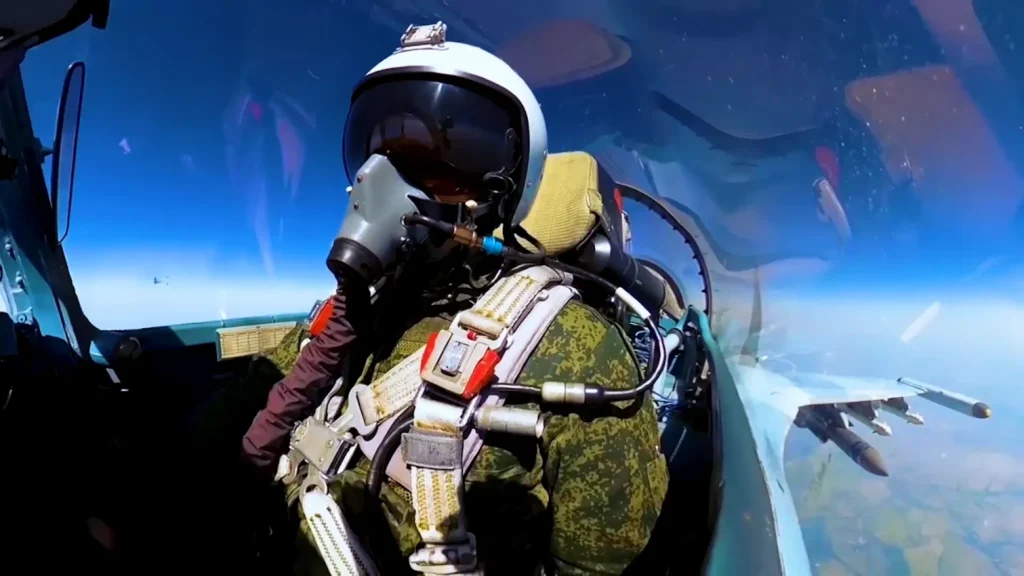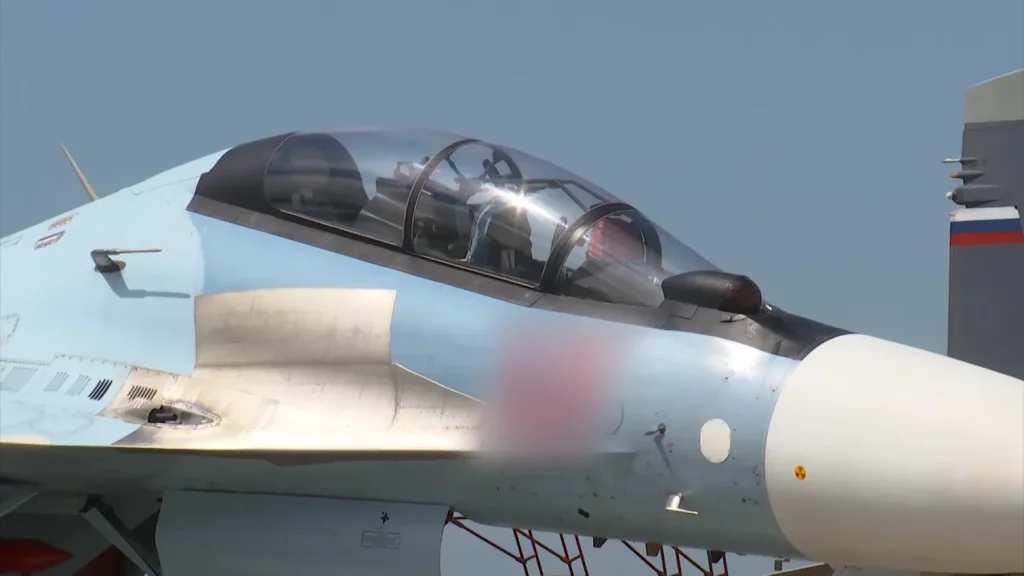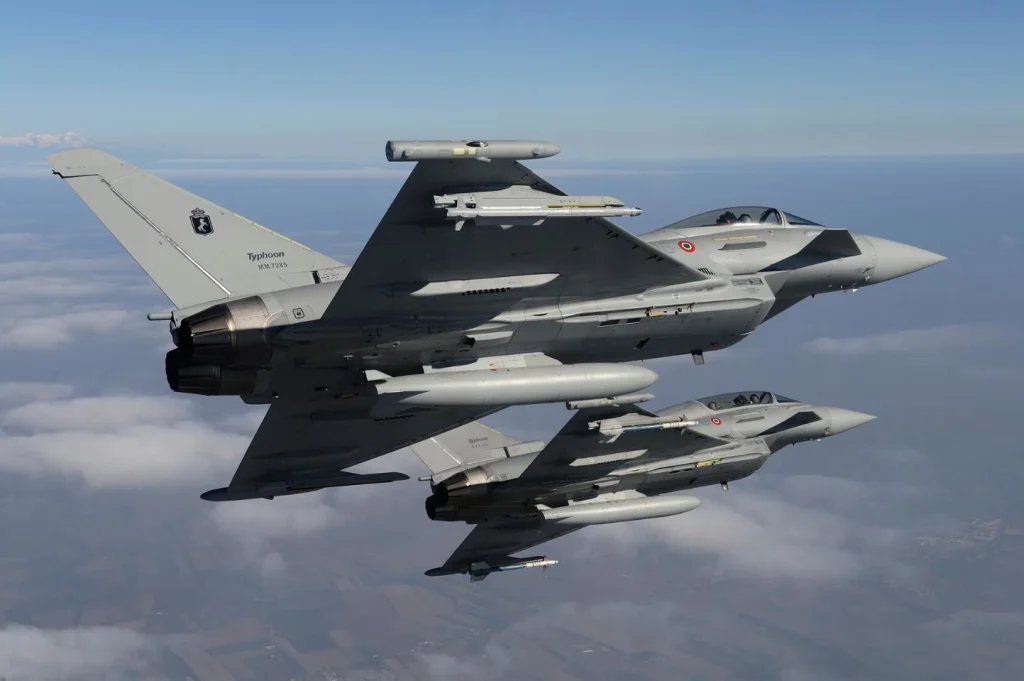Russia’s use of its Su-35 fighter aircraft in Ukraine has brought the plane under the spotlight. On the other hand, the war has drawn attention to the European security situation and the military preparedness of countries in this region. Aggressive Baltic Republics are likely to accidentally invite the first response from Russia forcing an unwilling NATO to react. Baltics are backed by even more aggressive U.K. PM Johnson, who said his country is considering deploying RAF Typhoon fighters and Royal Navy warships to protect southeastern Europe in April. In June, the Typhoons were engaged in training to protect the airspace of the Baltic States.
In the context of an apparent connection between fighter aircraft and a perceived security crisis, the Eurofighter Typhoon, a jet operated by four major European countries, has also come under scrutiny. How does the Su-35 compare with the Eurofighter Typhoon?
Development
Created at the Komsomolsk-on-Amur Aircraft Plant under the direction of the Sukhoi Design Bureau, the Su-35 refers to two improved derivatives of the Su-27 air-defence fighter. Su-35 is a single-seat, twin-engine, highly agile aircraft initially known as the Su-27M and was created by the Soviet Union from the Su-27. Sukhoi changed the aircraft’s designation to the Su-35 to gain export orders after the disintegration of the Soviet Union. To use the Su-27 as a temporary aircraft while the Sukhoi PAK FA (Su-57) programme was developed, Sukhoi, in 2003, started a second modernisation of the Su-27. This variation, also given the Su-35 designation, featured a new weapons control system, cockpit, and thrust-vectoring engines.
The Eurofighter Typhoon prides itself on being Europe’s largest military programme. It has four founding nations- the UK, Germany, Italy, and Spain- who all use the fighter plane in their air forces. The aircraft’s development essentially began in 1983, with the construction of the first Eurofighter Typhoon prototypes starting in 1989. The nations agreed that each would host the production line and final assembly for the aircraft components they were responsible for. It is currently manufactured by a consortium of BAE Systems, Airbus, and Leonardo. The plane can accommodate one or two crew. Like the Su-35, it is also a twin-engine, highly agile fighter that has been built for efficacy in dogfights and compatibility with a variety of armament and equipment.
Excluding pilot skills, team coordination, numbers, and environmental circumstances, an essential factor influencing chances of victory is the edge one aircraft has over the other based on technical specifications. This can be measured in terms of detection, endurance, weapons capacity etc.
Detectability
The Su-35 is 21.9 metres long and 5.9 m tall with a wingspan of 15.3 m. In comparison, the Eurofighter is 15.9 m long and 5.29 m tall. It has a wingspan of 10.9 m. A smaller size usually means the aircraft has a smaller radar-cross section (RCS). Smaller RCS, in turn, means that the object is harder to detect by enemy radars.
Apart from size, the Su-35 also has a larger RCS due to its large intakes, ineffective fan-blade shielding, vertical dual stabilisers, and thrust-vectoring jet nozzles. The Eurofighter’s RCS, on the other hand, is lesser because of its smaller size and greater use of radar-absorbent materials and signature management for canards. In addition, the Su-35 has a much larger heat signature than the Eurofighter due to its larger size, canted position of the engines, and the higher thrust needed.
Another aspect of detection is how well an aircraft can detect targets, enemy aircraft etc., around it. The Su-35S’s Irbis-E Passive Electronically Scanned Array (PESA) radar boasts incredibly high power levels. It allows for target detection beyond 300 kilometres and has claimed advancements in detecting low-observable threats like stealth fighters. The paradoxical drawback here is that because Irbis-E has to use extremely high power levels to achieve this performance, it becomes easily trackable and detectable. Coupled with the high RCS of the aircraft, this makes for a troublesome combination. This forces the aircraft to rely on out-ranging its adversaries beyond visual ranges (BVR) instead of sneaking up on them whilst relying on passive tracking.
The Eurofighter’s CAPTOR-M radar goes head-to-head with the Su-35’s Irbis-E radar regarding long-range tracking and detection in active scanning mode. However, it may be less effective at detecting low-observable threats. Yet, the Typhoon still has a clear advantage in passive tracking owing to Leonardo’s Praetorian Defensive Aids Sub-System (DASS). It protects against air-to-air and surface-to-air threats by” monitoring and proactively responding to the operational environment.” In addition, the system comprises electronic support measures, missile warning, onboard electronic countermeasures, and towed radar decoys that assist in detecting, evaluating, and countering threats at maximum range. The typhoon radar is improving with E-Scan AESA radar installation under Tranche 4 upgrades.
Endurance, Speed, Altitude
Endurance of an aircraft, referring to the maximum amount of time an aircraft can spend at cruising speed, can usually be compared by looking at the plane’s fuel capacity. The fuel capacity of the Su-35- 11,500 kilograms- far exceeds that of the Eurofighter- 5,000 kg.
Powered by a Saturn AL-41F1S engine, the Su-35 offers a maximum speed of 2.25 Mach. The aircraft’s service ceiling, i.e. the maximum height it can reach, is just a little short of 18,000 m. In comparison, the Eurofighter, powered by the E-J-200 engine, offers a top speed of 2 Mach. The service ceiling of this jet is a little short of 20,000 m.
It is important to note that both aircraft are capable of supercruising. However, the Typhoon’s speed without afterburners at combat loading is significantly higher than the Su-35. When comparing top speeds, the Eurofighter can still edge a slight advantage- the Su-35 carries twice as much when fully loaded as the European plane, but it also burns more fuel to maintain energy. The Eurofighter maintains more power during high-g turns and has better combat persistence during sustained afterburner-dependent manoeuvres in prolonged engagements. As a result, even though the Su-35’s thrust-to-weight ratio eventually catches up to Typhoon as fuel is burned off, it will continue to be at an energy disadvantage over time.
Altitude also comes into play. Su-35 is likely to be at a serious energy disadvantage during a BVR engagement at high altitudes, assuming both aircraft have detected one another. Typhoons would be flying at their higher service ceiling and faster supercruise speeds.
Weapons
The Su-35 has 12 hard points, while the Eurofighter has 13. However, the weapons carrying capacity of the Su-35 trumps that of the European jet. Despite having 13 pylons, the Typhoon can only use 8 of them to carry weapons – 6 BVR air-to-air missiles (AAM) and two short-range AAMs.
On the other hand, each of the Su-35’s 12 hard points can be equipped with a missile. Critically important electronic countermeasure (ECM) pods are stocked in the wingtip stations. Russia has more long-range firepower with 10 BVR missiles and 2–4 short-range missiles.
The Radar cross-section (RCS) of Su35 is known to be “1-3m2”, and the Typhoon is “0.5m2,” but both must be over 5m2 at full payload. The RCS of the Flanker would undoubtedly be greater than that of the Typhoons, but not by much. The difference in aircraft size is not particularly significant because of all those missiles and fuel tanks.

However, external loads do not affect radar performance, and the Su-35 does have a more powerful radar. Once the threat is within transmitting range, Eurofighter’s BriteCloud decoy jamming performs better, but the Su-35’s ECM can communicate over a greater area. Therefore, it is unlikely that the Typhoon would have an advantage in BVR.
Excellent Russian missile design expertise is advantageous for the Su-35. It is very challenging to defend against Russian fighters due to the variety of seeker-heads they use in their missile salvos when combatting Western fighters. The Su-35 can fire semi-active radar homing, anti-radiation (home on jam), and infrared homing missiles at a distance, while the ‘Archer series is still as lethal at close range.
On the other hand, the European aircraft have excellent short-range infrared homing (I.R.) missiles like the Advanced Short Range AAM (ASRAAM) and IRIS-T that can match or even outperform their Russian counterparts. Still, at long range, the Advanced Medium Range AAM (AMRAAM) is getting old, and against the Su-35S’ DRFM jamming technology, multiple missiles would probably be needed to take out each target.
However, the Eurofighter benefits from rules of engagement that permit long-range missile shots and high-velocity BVR combat, especially once the Meteor missile is fully integrated. In 2020, Russia unveiled a new R-37M Hypersonic Air to Air Missile to be deployed From the Su-35 Fighter. It is not yet known if it is in service. This missile is capable of tipping the BVR scales with its 400km range, Mach 6 and 60kg payload.
The Su-35 performs better in Within Visual Range (WVR) combat, especially at lower speeds and altitudes. Although the Su-35 is incredibly manoeuvrable, courtesy of its thrust-vectoring engines and massive lifting body, WVR is considered to be very dangerous. Unless a Typhoon pilot could find room to accelerate vertically to gain an energy advantage without being shot down in the process, Typhoon would likely be outmatched by the Su-35 WVR in both the horizontal and vertical planes.
Yet, it is imperative to consider that both aircraft are also fitted with helmet-mounted sights to trigger off-boresight missile shots and are armed with highly manoeuvrable I.R. missiles with excellent countermeasure resistance. Both would probably perish in a WVR “merge” with the other.
Electronic warfare (E.W.) and defensive tools
Russian EW capabilities are often outstanding. Their defensive toolkits, however, frequently lag behind those of their Western rivals. Although the specifics are highly classified, the Su-35 and Typhoon have some of the best DAS and E.W. capabilities that their respective countries can mount in frontline jets. It is plausible that Su-35 has the advantage in offensive E.W. and jamming capabilities while Typhoon has the edge in defensive aids and passive ELINT gathering.

The Su-35 does not rely as heavily on computers and software as the Eurofighter. Relying too much on computers also creates its own unique set of problems. Su-35 could likely match Typhoon’s reliability rate and outperform it in terms of ease of maintenance if used by a Western air force as part of a sizable, coordinated fleet. Currently, Su-35 is significantly less reliable than Typhoon as it is part of a Russian Air Force with various fighter types and patchy resources.
Easy flying and fighting thanks to the human-machine interface!
Russian jets have historically had trouble in this area. The Su-35 is less user-friendly to fly and use in combat than Typhoon, despite having multifunction cockpit displays and digital flight instruments.
Connection to a network
Typhoon dominates due to its advantages in connectivity, latest generation Link 16, MIDS, and lack of Russian Air Force standardisation. This disadvantage, however, might not be as significant for the Russian Air Force as it would be for a Western Air Force due to Russian tactical doctrine.
What is the state of the Russian Su-35 fleet right now?
48 Su-35S are currently in use in Russia, and another 48 are slated for production. The success of the new Saturn 117S thrust-vectoring engines, which have so far avoided many of the reliability issues of previous models, appears to give them a higher average serviceability rate than earlier iterations of the Su-27/30 family as well as the MiG-29. However, as with many other facets of the Russian military, the Su-35’s low production and service numbers, as well as its presence among a wide range of MiG-29 and Su-27/30 ancestors that do not share many essential parts, resulting in high operating costs and complicated logistics.
Except for small forward deployments like Syria, where the entire logistics chain can be focused on maintaining a small portion of the force at high readiness, this reduces serviceability to levels significantly below those of the US, British, and French fighter fleets.
Viable Comparison
Given the reluctance of the West to get its military involvement in any war since the Afghanistan debacle, it seems unlikely that a Su-35 and a Eurofighter would face each other off in a dogfight. However, if they do, the deciding factor would depend quite heavily on technical and non-technical factors mentioned earlier, viz., pilot skills, team coordination etc. Since neither the Eurofighter nor the Su-35 is decidedly better than the other in the technical aspects, if a battle does come down to those specifications, it would depend on whether a plane needs to show endurance or speed or detection skills, weaponry etc. in that particular fight. However, evaluating and comparing these capabilities provides a foundational basis for predicting, to some degree, the victor.


“Aggressive Baltic countries?”????? Wtf this supposed to mean? Russia is the aggressor, this article is bullshit!